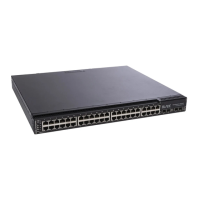108 RackSwitch G8000: Application Guide
Static Trunks
Static Trunk Requirements
When you create and enable a static trunk, the trunk members (switch ports) take
on certain settings necessary for correct operation of the trunking feature.
Before you configure your trunk, you must consider these settings, along with
specific configuration rules, as follows:
1. Read the configuration rules provided in the section, “Static Trunk Group
Configuration Rules” on page 108.
2. Determine which switch ports (up to 8) are to become trunk members (the
specific ports making up the trunk).
3. Ensure that the chosen switch ports are set to enabled. Trunk member ports
must have the same VLAN and Spanning Tree configuration.
4. Consider how the existing Spanning Tree will react to the new trunk
configuration. See Chapter 10, “Spanning Tree Protocols,” for Spanning Tree
Group configuration guidelines.
5. Consider how existing VLANs will be affected by the addition of a trunk.
Static Trunk Group Configuration Rules
The trunking feature operates according to specific configuration rules. When
creating trunks, consider the following rules that determine how a trunk group reacts
in any network topology:
•
All trunks must originate from one logical device, and lead to one logical
destination device. Usually, a trunk connects two physical devices together with
multiple links. However, in some networks, a single logical device may include
multiple physical devices, such as when switches are configured in a stack, or
when using VLAGs (see “Virtual Link Aggregation Groups” on page 159). In such
cases, links in a trunk are allowed to connect to multiple physical devices
because they act as one logical device.
•
Any physical switch port can belong to only one trunk group.
•
Trunking from third-party devices must comply with Cisco
®
EtherChannel
®
technology.
•
All trunk member ports must be assigned to the same VLAN configuration before
the trunk can be enabled.
•
When an active port is configured in a trunk, the port becomes a trunk member
when you enable the trunk. The Spanning Tree parameters for the port then
change to reflect the new trunk settings.
•
All trunk members must be in the same Spanning Tree Group (STG) and can
belong to only one Spanning Tree Group (STG). However if all ports are tagged,
then all trunk ports can belong to multiple STGs.
•
If you change the Spanning Tree participation of any trunk member to
enabled
or
disabled
, the Spanning Tree participation of all trunk members changes
similarly.
•
When a trunk is enabled, the trunk’s Spanning Tree participation setting takes
precedence over that of any trunk member.
•
You cannot configure a trunk member as a monitor port in a port-mirroring
configuration.
•
Trunks cannot be monitored by a monitor port; however, trunk members can be
monitored.
•
All ports in static trunks must be have the same link configuration (speed, duplex,
flow control).

